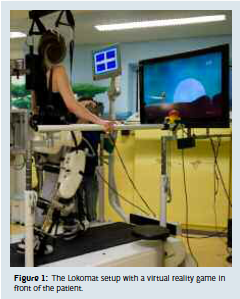By Karin Brütsch
Impaired movement, particularly walking, is frequently observed in patients with neurological disorders. Recent achievements in rehabilitation engineering resulted in the development of several robotic systems that aim to improve walking ability in these patients. These robot-assisted gait training (RAGT) devices, such as the Lokomat® (Hocoma AG, Volketswil, Switzerland), appear promising, since they might intensify locomotor training by increasing both the number of steps per training session as well as the training frequency, while decreasing the therapist’s manual assistance.
However, despite these positive effects, one complication of implementing robotic devices might be the patient’s passivity in the driven gait orthosis. It is believed that passive guidance is less effective for motor learning and restoration of walking when compared to active performance. Another possible shortcoming in RAGT might be the fact that rehabilitation training is indeed repetitive and repetition tends to “decouple” the mind and reduce patients’ motivation. Indeed, clinical experiments revealed that children in particular show little motivation towards the training process in a conventional repetitive RAGT, because this training is rather monotonous and provides little incentive to continue for longer periods of time. Thus, pediatric rehabilitation centers using RAGT try to boost the patient’s motivation by simultaneously showing DVDs or playing music. Such strategies, however, may distract children from the actual gait training, causing them to become completely passive and inattentive during the Lokomat ® training. Therefore, in RAGT, it appears essential that patients participate actively rather than just letting themselves “be walked.”
An advantage of RAGT devices combined with Virtual Reality (VR) (Figure 1) is that it has the capability to create a rehabilitation environment with individualized treatment needs while providing standardization of assessments and training protocols. During a training session the duration of training can be adjusted, as well as other factors such as intensity of training, the amount of force needed to support leg movements, walking speed, and provided support of body weight. A device like the Lokomat® provides consistent assistance and moves the patient’s legs along a predefined fixed trajectory, while also assessing forces between the patient and the leg orthoses. Indeed, these man-machine interaction forces at hip and knee joint linear drives provide feedback values and can be used to quantify the participant’s level of activity and participation during RAGT. By controlling and manipulating feedback parameters, VR games can be adequately adapted to the children’s cognitive and physical capacity, thereby keeping the level challenging and providing motivation without losing focus and attention on actual gait training. Several studies support the fact that patients’ motivation plays a crucial role in determining the outcome of therapy. Moreover, in certain patient populations it may even be the most critical factor in defining the success of rehabilitation training (e.g. children, stroke patients).

Indeed, preliminary studies demonstrated the success of adding virtual environments to RAGT and enhancing motivation of the patient during therapy. It was demonstrated that patients with neurological gait disorders and healthy children participated more actively – quantified by biofeedback values or leg EMG amplitudes – with VR-based RAGT than with other supportive interventions, such as watching DVDs or encouraging instructions by therapists. The gaming aspect of VR keeps children highly engaged during repetitive tasks.
In collaboration with different institutes, a new serious game was developed – Gabarello (“GAme BAsed REhabiliation for LOkomat”) – to counteract the problem of adequately maintaining children’s motivation during consecutive training sessions and to improve the quality of VR design elements and immersion. In this VR game Gabarello, the patient is immersed in an environment on another planet. A large monitor in front of the patient (Figure 1), portrays an astronaut exploring the planet’s surface by scouting different routes, collecting objects and planting plants that start blooming. By shifting the height of the legs, the color and the speed of the avatar, the environment reflects the patient’s active participation in the Lokomat® (Figure 2). In other words, the man-machine interaction forces of the patient in the Lokomat ® control the VR game. The level design of the game requires deliberate changes in exertion of the patient and therefore meets therapeutic goals.

Despite these new VR developments, our previous studies also showed that the therapist is still an important motivator, which might be of interest for defining optimal RAGT protocols. Indeed, according to our clinical experience, the use of VR during rehabilitation therapy should not replace the physical therapist, but rather provide an additional means of enhancing training efficiency and motivation. Further research should reveal whether an increase in motivation and active participation leads to a better functional outcome, as a result of patient cooperative strategies such as VR.
Karin Brütsch, Ph.D. Rehabilitation Centre of the University Children’s Hospital Zurich Switzerland Karin.Bruetsch@kispi.uzh.ch
About Brenda Wiederhold
President of Virtual Reality Medical Institute (VRMI) in Brussels, Belgium.
Executive VP Virtual Reality Medical Center (VRMC), based in San Diego and Los Angeles, California.
CEO of Interactive Media Institute a 501c3 non-profit
Clinical Instructor in Department of Psychiatry at UCSD
Founder of CyberPsychology, CyberTherapy, & Social Networking Conference
Visiting Professor at Catholic University Milan.






